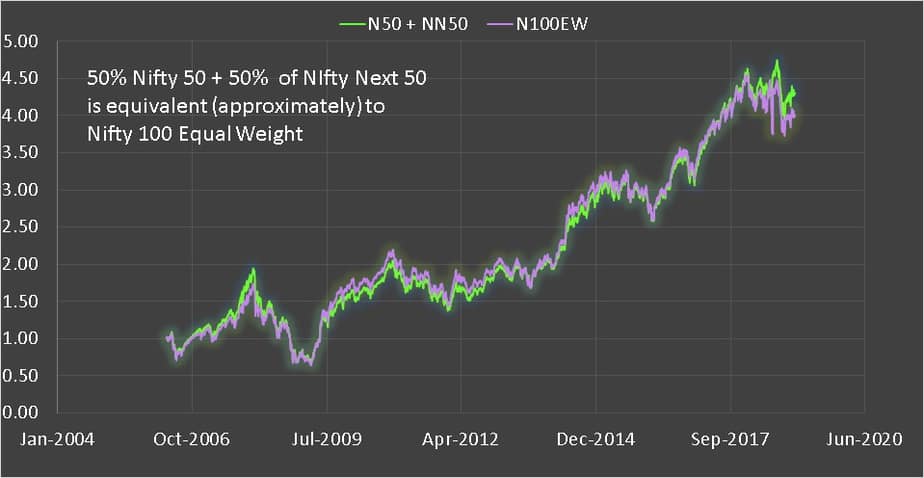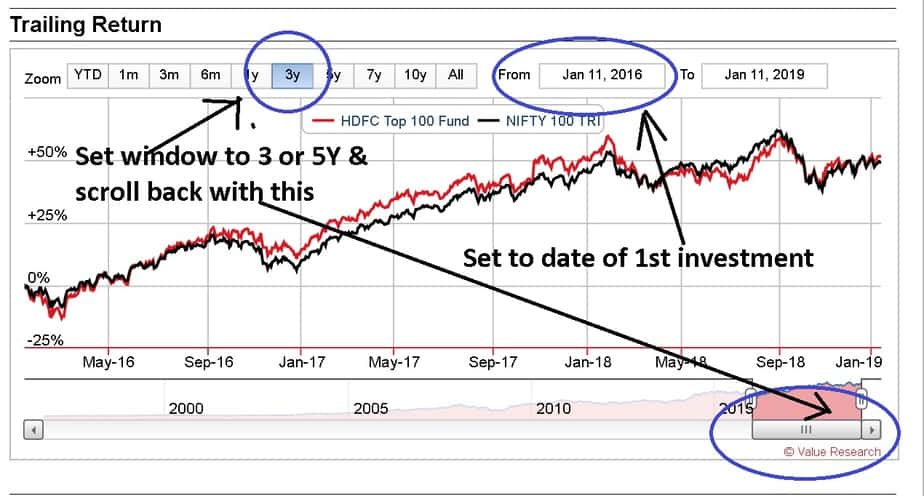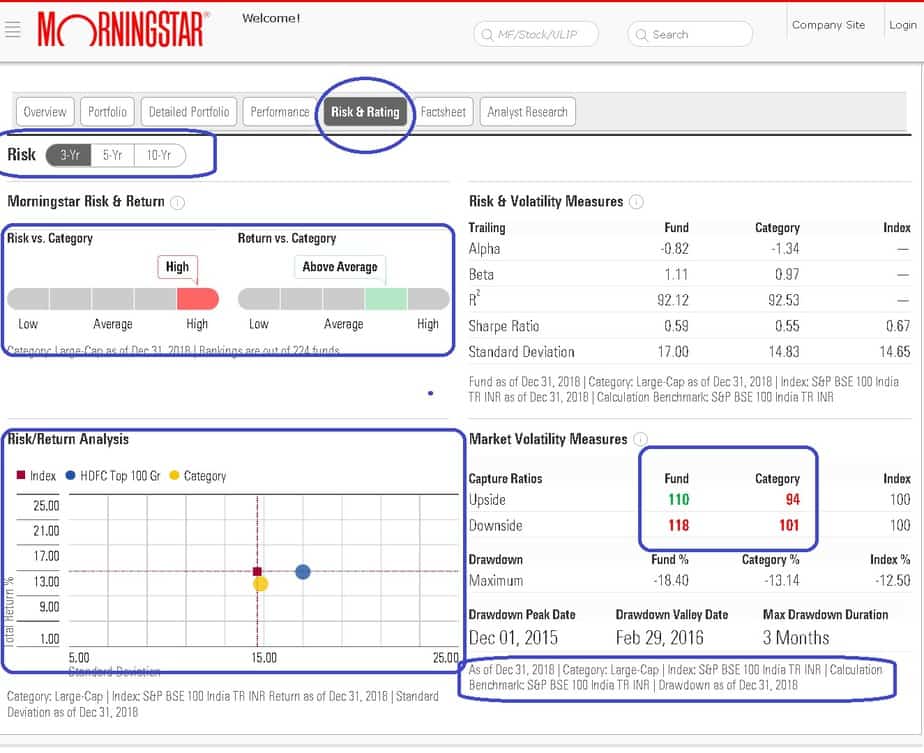Last Updated on December 29, 2021 at 12:08 pm
Here are three simple steps to review the mutual funds we hold. When we select a fund, we look at past performance: last three years, five years etc. However, the moment we buy units of a particular mutual fund, all that matter is its performance from that point in time.
For example, suppose we start a SIP from Jan 1st 2019, there is no point look at its star rating in Dec 2019. Why? Because the star rating analysis is studying performance from Dec 2016 to Dec 2019 (3 years) and Dec. 2014 to Dec 2019 (5 years). We have been invested only from Jan to Dec 2019. Each window would produce a different result. A fund could be 5-star rated if we consider the last 5Y, 2-star rated in the last 3Y and if one could rate between Jan-Dec 2019, it could just about be anything. Which is why I had compared this to blind men touching an elephant

Unless we know when to wear the analyst cap and when to wear an investor cap, only confusion would prevail. There is one exception. If our investment is three of five years old, then one could look at an analysis for that time frame. However, even here, peer comparison is stressful.
Join 32,000+ readers and get free money management solutions delivered to your inbox! Subscribe to get posts via email! (Link takes you to our email sign-up form)
🔥Want to create a complete financial plan? Learn goal-based investing? Exclusive access to our DIY tools? Increase your income with your skills? Enjoy massive discounts on our robo-advisory tool & courses! 🔥
Comparing mutual funds before investing differs from comparing mutual funds after investing. Which is why for the sake of our sanity, it is important to establish ground rules.
Ground rules for reviewing mutual funds
1: Give mutual funds at least three years from the day we started investments. We will have the confidence to allow this time only if we select select the right category of mutual fund for our goal
2: Focus on the portfolio first, individual fund next. When we review portfolio growth (hopefully only once a year!) we first consider overall portfolio returns and its value. See My personal financial audit 2018 for an example.
3: Review the performance of our funds from date of first investment first and only then consider performance in the last few years (AKA trailing returns).
4 Choose benchmarks for individual funds and the overall portfolio to test performance.
5 Avoid comparing one fund with another. This is like a parent comparing children:
“Why can’t you be more like Ajay, beta?”. Duh! because I am different, dad?!
6 If we must, then let us compare our fund with its category, provided we have been invested for longer than the period of comparison. For example: period of investment is last 5Y and period of comparison with the category is the last 3Y
Three simple steps to review mutual funds
Step 1: Compare your investments with a benchmark
- Use a portfolio tracker like Value Research, Perfios or my excel tracker (recommended!)
- Choose an appropriate benchmark for comparison.
- For a large cap fund use NIfty 100. Since this is not available as an index fund, use 80% Nifty 50 index fund and 20% Nifty Next 50 index fund.So if we invest Rs. 2000 a month in two large caps, then setup a portfolio record with 80% of Rs. 2000 = 1600 a month in Nifty 50 index and rest in Nifty next 50 index fund.
- 50% of NIfty 50 and 50% Nifty Next 50 will approximately emulate the performance of Nifty 100 Equal Weight Index and can be used for large and mid cap and/or multicap funds
- Nifty Next 50 is an excellent benchmark for aggressive multicap funds or mid cap funds. You can also use ETFs but will have to enter transactions manually for SIPs at Value Research. You can automate this in my sheet but with ETF NAV (not price) data.
- Nifty next 50 or a good mid cap fund can be used to benchmark a small cap fund
- The dates of investment in the benchmark funds should be the same as the dates in our funds.
- So when you buy some mutual fund units, enter a transaction for the same amount in the chosen benchmark.
- Accumulate this data for at least three years to judge funds. If after three years, the fund has not beat the chosen index, you will have to take a call. If the fund has performed well, then stay invested until the next review.
- If the fund has not performed, proceed to step 3


Step 2: Track performance with a funds benchmark
- In step 1, the benchmarks used were our own. We can repeat this exercise with the funds chosen benchmark.
- Go to the value research fund page and to the performance tab and do the following
- First the from date to date of 1st investment to check how the fund has performed wrt its benchmark during your invested period. If “okay” do not look again until next review.
- If not “okay” then scroll the horizontal bar to check how the fund has fared over a similar period in the past. The set the scroll window a bit longer say 5Y and check how the fund has fared in the past.
- If it has not done well over 3Y windows often but made up for it over 5Y, then you can take a chance and stay invested.
- If the performance has been better in the past and has dipped recently, then it is probably time to say good bye.
Step 3: Compare risk and reward with category
- For this step, your investment must at least be 3Y old in that fund
- Go to the Morningstar fund page
- Select 3Y or 5Y or 10Y.
- Observe the fund position in the risk and reward scales vs category.
- Look at the risk vs reward map (with yellow and blue dots) to check if the fund has beat the index and the category at lower risk or higher risk or has underperformed
- Check the downside capture (how much of index losses has fund capture) should be less than 100
- Check the upside capture (how much if index gains has fund captured). This is not important as shown here: Strange, but true! How mutual funds beat the index!
These numbers should give you enough information and enough confidence to stay invested or get rid of your funds.
So what do you think?
Those were three simple steps to review the funds we hold. Do they make sense? Is something not clear? Would you like add to this? How do you review your holdings? Share below.
Check out the latest videos from freefincal on Youtube
🔥Enjoy massive discounts on our courses, robo-advisory tool and exclusive investor circle! 🔥& join our community of 7000+ users!
Use our Robo-advisory Tool for a start-to-finish financial plan! ⇐ More than 2,500 investors and advisors use this!
Track your mutual funds and stock investments with this Google Sheet!
We also publish monthly equity mutual funds, debt and hybrid mutual funds, index funds and ETF screeners and momentum, low-volatility stock screeners.





- Do you have a comment about the above article? Reach out to us on Twitter: @freefincal or @pattufreefincal
- Have a question? Subscribe to our newsletter using the form below.
- Hit 'reply' to any email from us! We do not offer personalized investment advice. We can write a detailed article without mentioning your name if you have a generic question.
Join 32,000+ readers and get free money management solutions delivered to your inbox! Subscribe to get posts via email! (Link takes you to our email sign-up form)
About The Author
 Dr M. Pattabiraman(PhD) is the founder, managing editor and primary author of freefincal. He is an associate professor at the Indian Institute of Technology, Madras. He has over ten years of experience publishing news analysis, research and financial product development. Connect with him via Twitter(X), Linkedin, or YouTube. Pattabiraman has co-authored three print books: (1) You can be rich too with goal-based investing (CNBC TV18) for DIY investors. (2) Gamechanger for young earners. (3) Chinchu Gets a Superpower! for kids. He has also written seven other free e-books on various money management topics. He is a patron and co-founder of “Fee-only India,” an organisation promoting unbiased, commission-free investment advice.
Dr M. Pattabiraman(PhD) is the founder, managing editor and primary author of freefincal. He is an associate professor at the Indian Institute of Technology, Madras. He has over ten years of experience publishing news analysis, research and financial product development. Connect with him via Twitter(X), Linkedin, or YouTube. Pattabiraman has co-authored three print books: (1) You can be rich too with goal-based investing (CNBC TV18) for DIY investors. (2) Gamechanger for young earners. (3) Chinchu Gets a Superpower! for kids. He has also written seven other free e-books on various money management topics. He is a patron and co-founder of “Fee-only India,” an organisation promoting unbiased, commission-free investment advice.Our flagship course! Learn to manage your portfolio like a pro to achieve your goals regardless of market conditions! ⇐ More than 3,000 investors and advisors are part of our exclusive community! Get clarity on how to plan for your goals and achieve the necessary corpus no matter the market condition is!! Watch the first lecture for free! One-time payment! No recurring fees! Life-long access to videos! Reduce fear, uncertainty and doubt while investing! Learn how to plan for your goals before and after retirement with confidence.
Our new course! Increase your income by getting people to pay for your skills! ⇐ More than 700 salaried employees, entrepreneurs and financial advisors are part of our exclusive community! Learn how to get people to pay for your skills! Whether you are a professional or small business owner who wants more clients via online visibility or a salaried person wanting a side income or passive income, we will show you how to achieve this by showcasing your skills and building a community that trusts and pays you! (watch 1st lecture for free). One-time payment! No recurring fees! Life-long access to videos!
Our new book for kids: “Chinchu Gets a Superpower!” is now available!


Must-read book even for adults! This is something that every parent should teach their kids right from their young age. The importance of money management and decision making based on their wants and needs. Very nicely written in simple terms. - Arun.Buy the book: Chinchu gets a superpower for your child!
How to profit from content writing: Our new ebook is for those interested in getting side income via content writing. It is available at a 50% discount for Rs. 500 only!
Do you want to check if the market is overvalued or undervalued? Use our market valuation tool (it will work with any index!), or get the Tactical Buy/Sell timing tool!
We publish monthly mutual fund screeners and momentum, low-volatility stock screeners.
About freefincal & its content policy. Freefincal is a News Media Organization dedicated to providing original analysis, reports, reviews and insights on mutual funds, stocks, investing, retirement and personal finance developments. We do so without conflict of interest and bias. Follow us on Google News. Freefincal serves more than three million readers a year (5 million page views) with articles based only on factual information and detailed analysis by its authors. All statements made will be verified with credible and knowledgeable sources before publication. Freefincal does not publish paid articles, promotions, PR, satire or opinions without data. All opinions will be inferences backed by verifiable, reproducible evidence/data. Contact information: To get in touch, use this contact form. (Sponsored posts or paid collaborations will not be entertained.)
Connect with us on social media
- Twitter @freefincal
- Subscribe to our YouTube Videos
- Posts feed via Feedburner.
Our publications
You Can Be Rich Too with Goal-Based Investing
 Published by CNBC TV18, this book is meant to help you ask the right questions and seek the correct answers, and since it comes with nine online calculators, you can also create custom solutions for your lifestyle! Get it now.
Published by CNBC TV18, this book is meant to help you ask the right questions and seek the correct answers, and since it comes with nine online calculators, you can also create custom solutions for your lifestyle! Get it now.Gamechanger: Forget Startups, Join Corporate & Still Live the Rich Life You Want
 This book is meant for young earners to get their basics right from day one! It will also help you travel to exotic places at a low cost! Get it or gift it to a young earner.
This book is meant for young earners to get their basics right from day one! It will also help you travel to exotic places at a low cost! Get it or gift it to a young earner.Your Ultimate Guide to Travel
 This is an in-depth dive into vacation planning, finding cheap flights, budget accommodation, what to do when travelling, and how travelling slowly is better financially and psychologically, with links to the web pages and hand-holding at every step. Get the pdf for Rs 300 (instant download)
This is an in-depth dive into vacation planning, finding cheap flights, budget accommodation, what to do when travelling, and how travelling slowly is better financially and psychologically, with links to the web pages and hand-holding at every step. Get the pdf for Rs 300 (instant download)

